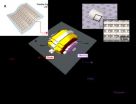(Press-News.org) DURHAM, N.C. -- Programs that aim to curb teen prescription drug abuse have vastly differing effectiveness, ranging from big drops in drug abuse to no measurable effect, according to a new study of 11,000 teenagers by researchers at Duke and Pennsylvania State universities.
The best results came from pairing a school-based program with a home-based intervention, resulting in a 10 percent decrease in abuse rates. By contrast, most school-based programs were ineffective when used by themselves, with just one exception.
The six-year study is among the first to measure the success and cost-effectiveness of prescription drug abuse prevention efforts.
Abuse of prescription opioids, a form of painkiller, is the fastest-growing form of illicit drug use in the country, affecting more than 12 million Americans and killing more people annually than heroin and cocaine combined, according to the Centers for Disease Control and Prevention. As a result, the U.S. Food and Drug Administration has recommended restricting access to painkillers such as Percocet, Oxycontin and Vicodin.
"These drugs are very available, and highly addictive," said Max Crowley, an NIH Research Fellow at Duke's Center for Child and Family Policy. "There's a growing national debate about whether we should restrict access to these drugs, but at the same time, the drugs are hugely important for pain management. What's being left out of the debate is the role of prevention."
Crowley and his co-authors found that only one school-based program was effective when used by itself. The Life Skills Training program resulted in 4 percent lower drug abuse rates, compared with a control group. The 18-session course teaches social skills that build competence and encourage assertiveness.
Life Skills Training was also among the most cost-effective programs studied, costing an average of $15 per child, Crowley said. By contrast, the study notes that prescription drug abusers cost society an average of $7,500 each for treatment and other expenses, by conservative estimates.
Life Skills was among four prevention programs the researchers studied. The team looked at 28 rural public school districts in Iowa and Pennsylvania, tracking students from grades 6 through 12. They examined a home-based program called Strengthening Families 10-14 and three school-based programs: Life Skills Training, Project Alert and All Stars. All four were "universal" programs that were offered to all teenagers in a given district.
The researchers analyzed pairs of demographically similar school districts. Within each pair, one community received a prevention program or programs, and the other did not. The research team surveyed teenagers each year, asking teens to anonymously report whether they had ever used a prescription painkiller for nonmedical purposes. The authors then compared drug use levels in districts that received interventions versus those that did not.
In communities that received no intervention, a quarter of high school seniors reported having misused prescription painkillers. The most substantial reductions in abuse rates occurred when the Life Skills program was combined with the Strengthening Families program. The All Stars intervention also yielded reductions when it was used alongside the Strengthening Families program.
Crowley said he hopes policymakers and educators will put the findings to use.
"Policymakers and other leaders are actively searching for efficient ways to curb prescription drug abuse," Crowley said. "These results give policymakers options regarding how to handle this growing epidemic. "
The study appears online in Preventive Medicine.
INFORMATION:
Data Collection for the PROSPER Trial was funded by NIH grant R01 DA 013709. All other phases of the study were funded by NIH training grant T32 DA 0176. Daniel Max Crowley's work was supported by a grant from the National Institute on Drug Abuse (F32-DA034501).
CITATION: "Can We Build an Efficient Response to the Prescription Drug Abuse Epidemic? Assessing the Cost Effectiveness of Universal Prevention in the PROSPER Trial," Daniel Max Crowley, Damon E. Jones, Donna L. Coffman and Mark T. Greenberg. Preventive Medicine, February 2014. DOI: 10.1016/j.ypmed.2014.01.029
http://www.sciencedirect.com/science/article/pii/S0091743514000620
In fight against teen prescription drug abuse, one-two punch wins
Large survey finds pairing school and home programs most effective
2014-02-18
ELSE PRESS RELEASES FROM THIS DATE:
Research team establishes benchmark set of human genotypes for sequencing
2014-02-18
Led by biomedical engineer Justin Zook of the National Institute of Standards and Technology, a team of scientists from Harvard University and the Virginia Bioinformatics Institute of Virginia Tech has presented new methods to integrate data from different sequencing platforms, thus producing a reliable set of genotypes to benchmark human genome sequencing.
"Understanding the human genome is an immensely complex task and we need great methods to guide this research," Zook says. "By establishing reference materials and gold standard data sets, scientists are one step closer ...
Smartphone app aids college-age women in abusive relationships
2014-02-18
COLUMBIA, Mo. –Women between the ages of 18 and 24 are at the highest risk for dating violence, according to the Centers for Disease Control and Prevention. However, these women are less likely than older adults to seek formal safety resources and instead look to peers or technology for help and advice. In an effort to connect more young women with safety information, University of Missouri researchers collaborated with Johns Hopkins University School of Nursing and the One Love Foundation to develop the "One Love My Plan" smartphone application, an interactive tool that ...
Breakthrough development of flexible 1D-1R memory cell array
2014-02-18
With the introduction of curved smartphones, flexible electronic goods are gradually moving to the center stages of various markets. Flexible display technology is the culmination of the latest, cutting-edge electric cell device technology. Developing such products, however, requires not only a curved display, but also operational precision of other parts, including the memory, in a flexible state.
Dr. Tae-Wook Kim at KIST announced their successful development of a 64-bit memory array using flexible and twistable carbon nano material and organo-polymer compound, which ...
Medicare beneficiaries return to emergency rooms after nursing home discharge
2014-02-18
Nursing homes are widely used by Medicare beneficiaries who require rehabilitation after hospital stays. But according to a recent study led by a researcher at the University of North Carolina at Chapel Hill School of Nursing, a high percentage of Medicare patients who are discharged from nursing homes will return to the hospital or the emergency room within 30 days.
"Nearly two million older adults use this benefit every year," said assistant professor Mark Toles, the first author of the study. "Before this study, we didn't recognize the large number of older adults ...
Healthy Lunchbox Challenge helps influence healthy eating habits in children
2014-02-18
AUDIO:
Falon Tilley and Michael W. Beets discuss the successful implementation of the Healthy Lunchbox Challenge, an innovative theory and incentive-based program, at four large-scale, community-based summer day camps. They observed...
Click here for more information.
PHILADELPHIA, PA, February 18, 2014 – During the school year, 21 million children receive free or reduced-price lunches, yet less than 10% of those children participate in the Department of Agriculture's Summer ...
Metal in the heart is non-hazardous to health
2014-02-18
Jena (Germany) A trousers button, a coin or a watch can be dangerous for people with a nickel allergy. Approximately 1 in 10 Germans is allergic to the metal. "This raises the question of the safety of medical implants containing nickel," explains Professor Dr. Markus Rettenmayr of the Friedrich Schiller University Jena (Germany). Nickel-titanium alloys are increasingly used as material for cardiovascular implants in minimal invasive surgery. Once implanted, nickel-titanium alloys can release small amounts of nickel due to corrosion phenomena, the holder of the Chair of ...
Investment bankers lead businesses to better mergers, acquisitions
2014-02-18
BUFFALO, N.Y. – Corporations with board directors who have investment banking experience are more likely to acquire other businesses – and make better acquisitions when they do – according to a new study from the University at Buffalo School of Management.
Forthcoming in the Journal of Financial Economics, the study found that directors with investment banking experience help their firms to select better businesses to acquire, more accurately determine the value of the target business and either reduce reliance on mergers and acquisition consultants or negotiate lower ...
Molecular biology mystery unravelled
2014-02-18
The nature of the machinery responsible for the entry of proteins into cell membranes has been unravelled by scientists, who hope the breakthrough could ultimately be exploited for the design of new anti-bacterial drugs.
Groups of researchers from the University of Bristol and the European Molecular Biology Laboratory (EMBL) used new genetic engineering technologies to reconstruct and isolate the cell's protein trafficking machinery.
Its analysis has shed new light on a process which had previously been a mystery for molecular biologists.
The findings, published today ...
Personality and spaces, remaking love, meaning in life, and commonsense morality
2014-02-18
People and spaces, the tragedy of commonsense morality, myths about meaning of life, and remaking love were four themes at the Society for Personality and Social Psychology (SPSP) conference in Austin. Researchers presented new work, showing how psychology reaches into our everyday lives. Video from four of these talks is now available online.
Highlights include:
Sam Gosling of the University of Texas-Austin described how the link between our emotions and spaces is is inseparable. As such, our spaces say a lot about us. In new work, Gosling and colleagues identified ...
One-quarter of high risk patients denied anticoagulation after AF ablation
2014-02-18
Sophia Antipolis, 18 February 2014: One-quarter of high risk patients do not receive anticoagulants after ablation of atrial fibrillation (AF), according to the latest survey of European practice.
The EORP Atrial Fibrillation Ablation Pilot Study, conducted by the European Heart Rhythm Association (EHRA) of the European Society of Cardiology (ESC), reveals that 65% of patients were taking anticoagulants one year after ablation of AF.1 But up to 25% of patients at high risk of stroke (defined as a CHA2DS2-VASc score >1) were not taking any anticoagulant drug. And around ...
LAST 30 PRESS RELEASES:
Longest observation of an active solar region
Why nail-biting, procrastination and other self-sabotaging behaviors are rooted in survival instincts
Regional variations in mechanical properties of porcine leptomeninges
Artificial empathy in therapy and healthcare: advancements in interpersonal interaction technologies
Why some brains switch gears more efficiently than others
UVA’s Jundong Li wins ICDM’S 2025 Tao Li Award for data mining, machine learning
UVA’s low-power, high-performance computer power player Mircea Stan earns National Academy of Inventors fellowship
Not playing by the rules: USU researcher explores filamentous algae dynamics in rivers
Do our body clocks influence our risk of dementia?
Anthropologists offer new evidence of bipedalism in long-debated fossil discovery
Safer receipt paper from wood
Dosage-sensitive genes suggest no whole-genome duplications in ancestral angiosperm
First ancient human herpesvirus genomes document their deep history with humans
Why Some Bacteria Survive Antibiotics and How to Stop Them - New study reveals that bacteria can survive antibiotic treatment through two fundamentally different “shutdown modes”
UCLA study links scar healing to dangerous placenta condition
CHANGE-seq-BE finds off-target changes in the genome from base editors
The Journal of Nuclear Medicine Ahead-of-Print Tip Sheet: January 2, 2026
Delayed or absent first dose of measles, mumps, and rubella vaccination
Trends in US preterm birth rates by household income and race and ethnicity
Study identifies potential biomarker linked to progression and brain inflammation in multiple sclerosis
Many mothers in Norway do not show up for postnatal check-ups
Researchers want to find out why quick clay is so unstable
Superradiant spins show teamwork at the quantum scale
Cleveland Clinic Research links tumor bacteria to immunotherapy resistance in head and neck cancer
First Editorial of 2026: Resisting AI slop
Joint ground- and space-based observations reveal Saturn-mass rogue planet
Inheritable genetic variant offers protection against blood cancer risk and progression
Pigs settled Pacific islands alongside early human voyagers
A Coral reef’s daily pulse reshapes microbes in surrounding waters
EAST Tokamak experiments exceed plasma density limit, offering new approach to fusion ignition
[Press-News.org] In fight against teen prescription drug abuse, one-two punch winsLarge survey finds pairing school and home programs most effective



